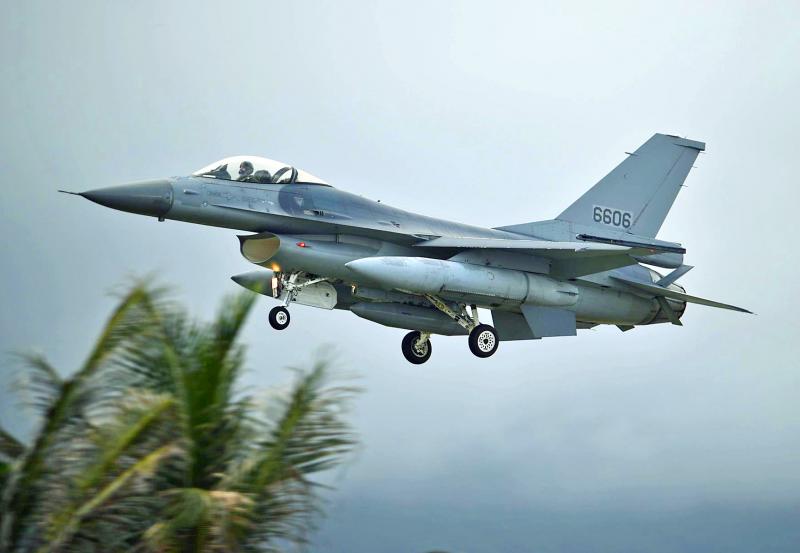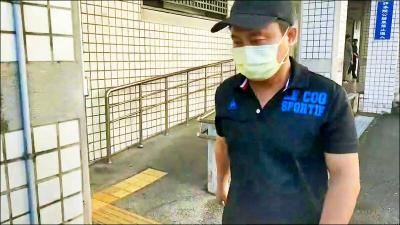A Taiwanese F-16 air force jet made a hard landing at an airport in Honolulu due to a landing gear malfunction, a military source said yesterday. No one was injured.
The source confirmed the incident to the Central News Agency after Hawaiian media reported the incident, which took place at about 2:45pm on Monday, leading to a runway at Daniel K Inouye International Airport being temporarily closed.
The Ministry of National Defense refused to comment on the report yesterday, but a military source said that the jet was owned by the air force.

Photo: Yu Tai-lang, Taipei Times
A Hawaii State Transportation Department spokesperson said the jet made a hard landing and came to rest on its nose after its landing gear did not deploy, according to a Hawaii News Now report, which also cited sources as saying that the aircraft came from Arizona.
Some Taiwanese media later reported that the F-16 belonged to the air force and had been on a training mission at Luke Air Force Base in Arizona.
The source said the jet was flying from Arizona back to Taiwan, and the incident took place when the jet was making a stopover in Hawaii to refuel, adding that the aircraft did not sustain major damage.
No other information was immediately available on how long the aircraft would be in Hawaii and what repairs need to be made before it can return to the skies.
The source said the F-16 is one of about 10 F-16A/Bs currently being used on a training mission with Luke Air Base’s 21st Fighter Squadron, as part of a Taiwan-US training program that began in the 1990s when Taiwan purchased its first batch of the jets from the US.
The jet was flying back to Taiwan to be upgraded into the more advanced F-16V format as part of the air force’s ongoing retrofitting project launched in 2016, the source said.
The program involves a retrofit of all 141 of Taiwan’s F-16A/Bs into F-16Vs, which are equipped with more advanced avionics, including an APG-83 scalable agile beam radar, a helmet-mounted cueing system, and other flight management and electronic warfare systems.
Although the training program at Luke Air Force Base has existed since the 1990s, the US has rarely discussed it until recently due to the sensitivity of the issue.
In 2019, the administration of then-US president Donald Trump made the program public when announcing a round of arms sales to Taiwan.
Given that the US usually only trains the standing forces of major allies, such as NATO members, its decision to make public the training of Taiwanese fighter pilots signaled its close military ties with Taiwan, a source said at the time.

South Korean K-pop girl group Blackpink are to make Kaohsiung the first stop on their Asia tour when they perform at Kaohsiung National Stadium on Oct. 18 and 19, the event organizer said yesterday. The upcoming performances will also make Blackpink the first girl group ever to perform twice at the stadium. It will be the group’s third visit to Taiwan to stage a concert. The last time Blackpink held a concert in the city was in March 2023. Their first concert in Taiwan was on March 3, 2019, at NTSU Arena (Linkou Arena). The group’s 2022-2023 “Born Pink” tour set a

CPBL players, cheerleaders and officials pose at a news conference in Taipei yesterday announcing the upcoming All-Star Game. This year’s CPBL All-Star Weekend is to be held at the Taipei Dome on July 19 and 20.

The Taiwan High Court yesterday upheld a lower court’s decision that ruled in favor of former president Tsai Ing-wen (蔡英文) regarding the legitimacy of her doctoral degree. The issue surrounding Tsai’s academic credentials was raised by former political talk show host Dennis Peng (彭文正) in a Facebook post in June 2019, when Tsai was seeking re-election. Peng has repeatedly accused Tsai of never completing her doctoral dissertation to get a doctoral degree in law from the London School of Economics and Political Science (LSE) in 1984. He subsequently filed a declaratory action charging that

The Hualien Branch of the High Court today sentenced the main suspect in the 2021 fatal derailment of the Taroko Express to 12 years and six months in jail in the second trial of the suspect for his role in Taiwan’s deadliest train crash. Lee Yi-hsiang (李義祥), the driver of a crane truck that fell onto the tracks and which the the Taiwan Railways Administration's (TRA) train crashed into in an accident that killed 49 people and injured 200, was sentenced to seven years and 10 months in the first trial by the Hualien District Court in 2022. Hoa Van Hao, a